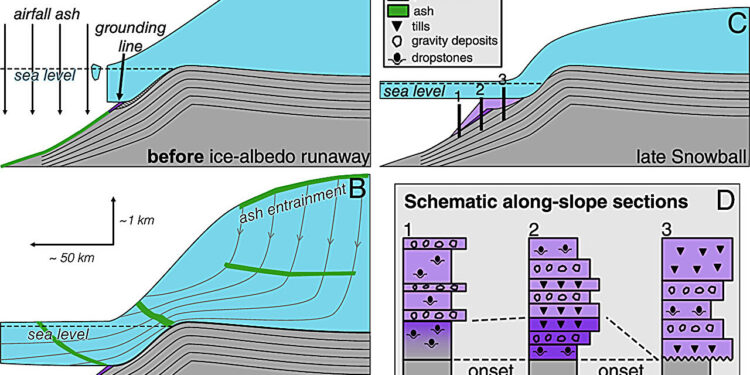Growth of idealized ice and stratigraphy at the start of snowball earth. Credit: Proceedings of the National Academy of Sciences (2025). DOI: 10.1073 / PNAS.2418281122
Scientists from the University of California, Berkeley and the State University of Boise found evidence suggesting that the Glaciation in Marinoan began around 639 million years ago and lasted around 4 million years. In their study published in the Proceedings of the National Academy of SciencesThe group used drone and field images as well as isotopic dating of glacial deposits to learn more about global glaciation events during the neoproterozoic era.
Previous research has shown that during the first days of the planet, during the neoproterozoic era, the earth underwent two ages of ice. The first, known as Sturtian glaciation, lasted around 56 million years and covered the whole ice planet. We know less about the second event, called the Glaciation of the Marinoan. In this new effort, the research team set for the task of understanding when it started and how long it lasted.
The work involved sending drones to part of Namibia, where previous research has revealed evidence of glacial activity during the Marinoan. This allowed the team to map sedimentary layers which were stacked in a way that showed that little vertical gap had occurred, which meant that the glaciers did not move a lot while they were there. Additional fields have helped confirm what the team has found in the drone images.
The team then carried out the isotopic dating of the layers of ash that had accumulated during the start of the Marinoan, then continuing. The layers of ash are evidence of volcanic activity which has probably triggered the ice age. They also noted models in the accumulated ashes that suggested a single cold spell, rather than a series of hot and cold periods.
Representative stratigraphy and geochronology at Fransfontein Ridge. Credit: Proceedings of the National Academy of Sciences (2025). DOI: 10.1073 / PNAS.2418281122
Overall, the evidence allowed researchers to determine the time when the glaciation of Marinos began – about 639 million years ago – and how long it lasted – around 4 million years.
The study of the two glacial events during the neoproterozoic era led to questions about how life could have survived these cold conditions, when thick ice layers covered the whole planet. Some suggested that this was probably due to hot geothermal vents on the bottom of the ocean that could have served as a refuge.
More information:
Adrian R. Tasistro-Hart et al, Marinoan Snowball of four million years shows several roads to deglaciation, Proceedings of the National Academy of Sciences (2025). DOI: 10.1073 / PNAS.2418281122
© 2025 Science X Network
Quote: Snowball Earth: drone cartography and isotopic meetings suggest that the Marinoan glaciation lasted 4 million years (2025, April 28) recovered on April 28, 2025 from
This document is subject to copyright. In addition to any fair program for private or research purposes, no part can be reproduced without written authorization. The content is provided only for information purposes.



